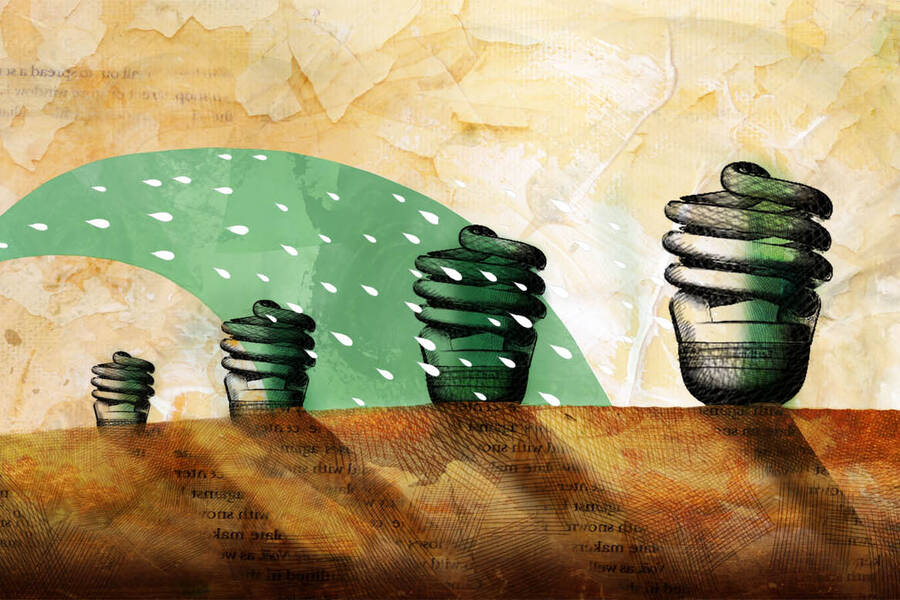Social Impact Finance & Accounting Dec 2, 2016
What Is the Future of Impact Investing?
“People are revisiting the relationship they want their capital to have with the world.”

Lisa Röper
Over the past decade, investors ranging from individuals to large funds are increasingly putting their money where their mouths—and their futures—are, in ventures that prove their commitment to socially and environmentally sustainable products and strategies.
This growing awareness around issues of sustainability has led to an expansion of the field of impact investing. In the process, investors have been developing better and better strategies and products for their portfolios, while companies presenting themselves to investor networks have had to step up their games and show that they are concerned about impact and results.
Kellogg Insight sat down with Amit Bouri, CEO of the Global Impact Investing Network (GIIN), an organization formed to help the industry grow and operate more efficiently, and David Chen, an adjunct professor of finance and program director of impact investing at the Kellogg School and chairman of Equilibrium Capital Group, to discuss the future of impact investing.
This interview has been edited for length and clarity.
Kellogg Insight (KI): How is impact investing today different than it was, say, five or ten years ago?
Amit BOURI: We are seeing more client demand. People are revisiting the relationship they want their capital to have with the world. They are seeking a role for capital to play beyond just maximizing profits for a given level of risk, and thinking about social and environmental issues that can be addressed through investment.
We’re seeing this from wealthy individuals who have a lot of capital, as well as control and influence over how that capital is invested. But we are also seeing this from ordinary citizens, pensioners who are asking those pension funds to respond to local community issues, or global issues like climate change, through their investment strategies.
David CHEN: A lot of the first-generation impact products were venture capital funds that targeted developing countries.
But in the last few years, you’ve seen both sustainable investing and impact investing expand beyond the venture capital model into instruments across the entire asset allocation, including private equities, public equities, fixed income and debt offerings, and real assets.
We’re finding that mainstream investment firms are responding to two primary catalysts. Their clients are looking for impact-investing strategies. You have one group of investors asking for impact products who tend to think, “my money should do more than bring returns.”
Then you have institutional investors who have a slightly different focus. They are thinking about sustainability as affected by global demographics, resource consumption, asset productivity, and climate change. Institutions examine their portfolios from a risk-management standpoint: If these factors are in fact real, what do we have to be doing to protect our long-term assets? How can we make sure that we are benefiting from these trends and riding the right macroeconomic shifts?
Traditional investment firms are responding to both sets of client requirements. In the past five years, we have moved from white papers and strategy to mainstream traditional investment firms bringing out products. The quality of these products has dramatically increased over the past 24–36 months.
BOURI: And this diversification is key. People are exploring how they can achieve impact throughout their portfolios. As Dave mentioned, there are impact-investment strategies in a variety of asset classes, from low-risk, low-return categories like cash management all the way up through high-risk, high-return alternative spaces.
Some larger institutional firms are starting in a specific sector—maybe something like microfinance or renewable energy—and then diversifying from wherever they begin. Others are starting with a specific allocation toward impact investing and then taking a multi-sector approach. Traditional firms like Bain Capital, or more recently Texas Pacific Group, have launched dedicated impact-investment funds and are either building a team internally or partnering with strategic partners to externally manage those funds.
KI: What areas are investors identifying for investment opportunities?
CHEN: Specific examples include carbon credits to fulfill the California AB 32 carbon cap protocols, water, renewable energy including solar and wind, and affordable housing.
The scaling of sustainable organic farming is another opportunity area. Most people, when they use the words “organic farming,” think about farm stands. They’re not thinking about the fact that every grocery store in the U.S. carries organic vegetables and fruits. What farm system is necessary to make that happen?
KI: How can investors identify local, regional, national, or global investing opportunities?
BOURI: One of the things that GIIN is invested in is building a community, a network of investors. Our membership is now over 230 organizations, in 32 countries. Hopefully, through those connections, we will help facilitate the flow of opportunities, ideas, and capital.
We also have tools like ImpactBase, which is a free, searchable online directory of impact-investment funds and products available to accredited investors. It started with about 30 impact-investment funds and products, and now has over 400. You can use this tool to get a sense of the opportunity that is out there.
“The comment ‘I couldn’t find these products’ may have been accurate three years ago—but today there’s no excuse for not being able to identify the best-in-class products.” —David Chen
CHEN: Many of the portfolio consulting firms that serve the large endowments, foundations, and pension plans are building significant databases of impact- and sustainable-investment funds. The comment “I couldn’t find these products” may have been accurate three years ago—but today there’s no excuse for not being able to identify the best-in-class products.
KI: What steps can startups take to get on the radar of impact investors?
CHEN: Keep in mind that Venture capital represents less than one percent of the total asset allocation—even if they occupy 90 percent of our cocktail-hour conversations. Startups are a very small part of institutional portfolios.
But to the extent that firms want to make themselves more attractive to social and impact venture funds, they need to move beyond slideshows. The world has now moved to quantifiable metrics. No matter what metrics you use, show me tangibly how you’re impacting lives, how you’re impacting the environment. Don’t show me a slideshow that says, “We’re better for poor people.” I want to know how. This need for quantification has increased.
One mistake that social enterprise entrepreneurs will make is to think that they will be treated differently because they’re changing the world—that the benchmarks will be looser or more charitable when investors look at them. That’s no longer the norm or the expectation. If we invest in a firm, we expect good performance, solid growth, profitability, and the ability to sustain growth. Just because you’re solving the woes of society, you don’t get off the hook on that.
BOURI: Rigor in terms of a business’s strategy and operations is really critical, from both financial-performance and impact standpoints. You don’t get a free pass on either of those just due to good intentions. Rather, you need to be incredibly thoughtful about how you’re going to be a successful business and sophisticated about how you’re going to achieve an impact. Neither of those is particularly easy to do, but both are certainly possible.
CHEN: If you want to change the planet, you better learn your way around a spreadsheet.
KI: What do you see as the future of impact investing?
BOURI: When we started the GIIN seven years ago, big firms stood out if they were doing impact investing. I think we’re moving to a world in which you’ll start to stand out if you’re not doing impact investing in some way or another.
What is really exciting is we’re seeing the professionalization of this field—a transition from it being a niche market to something much more mainstream. The adoption of impact-investment strategies—the pursuit of them around the world, from major institutional investors to individual investors—really speaks to a powerful trend that we hope continues for quite some time.
We’re still in the early stages of understanding the true impact that investing can have in terms of any number of social and environmental issues. We have a strong evidence base now, a track record in the market, but we haven’t hit the boundaries. I don’t think we’ve even approached them in terms of the impact that we can have. That’s why this market is so exciting for me personally—and I think there is still an opportunity for every talented individual to make their mark in this market.
CHEN: Knock on wood that it actually stays in place, but the 2015 ERISA clarification from the Department of Labor says it all—basically, that while corporate pension plans still have a primary fiduciary duty to the pensioners and to the pension plan, environmental, social, and governance (ESG) factors are to be viewed as material input into the investment decisions process.
Which means fiduciaries have permission in their legal jurisdiction as pension trustees to consider ESG as a legitimate part of the investment decision-making process. This sets a tone for the future that these factors are just another part of good, sound investing.



